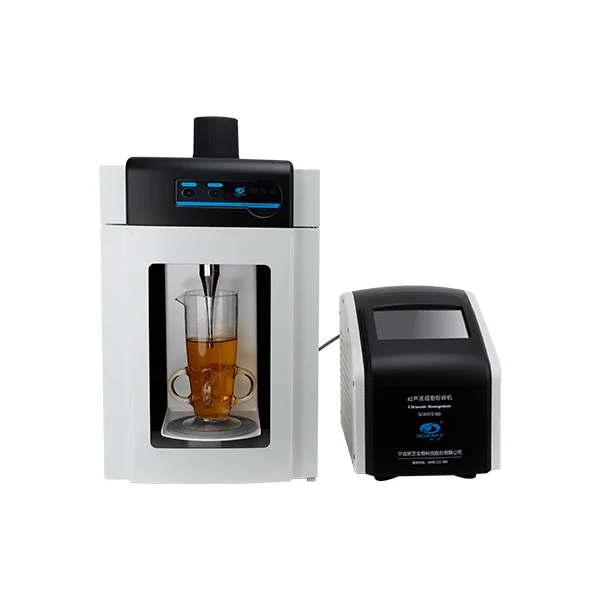In modern laboratory research, precise and efficient sample processing is crucial for scientific success. As an advanced laboratory instrument, the probe sonicator has become an indispensable tool in fields such as life sciences, materials science, and environmental research due to its efficiency, flexibility, and versatility. This article will provide a detailed introduction to the probe sonicator's operating principles, application scenarios, core advantages, and value in research and industry, helping researchers fully understand its functions and key selection criteria.
1. What is a Probe Sonicator?
A probe sonicator, also known as a probe sonicator, is a laboratory device that processes liquid or solid samples through the ultrasonic cavitation effect. Its core operating principle is to transmit high-frequency mechanical vibrations into the sample liquid, forming tiny bubbles that quickly collapse and release strong localized shear forces, thereby achieving effects such as cell disruption, sample emulsification, and nanoparticle dispersion.
Compared to traditional bath sonication, the probe sonicator offers the following significant advantages:
High energy density: The probe directly contacts the sample, concentrating energy and achieving high processing efficiency.
Adjustable power and pulse mode: The power and pulse duration can be precisely adjusted to suit experimental requirements, adapting to varying sample volumes and properties. Sample Protection: Equipped with a temperature monitoring system, it prevents heat-sensitive samples from being damaged by high energy.
These advantages are further optimized in the Scientz Probe Ultrasonicator, ensuring efficient processing of samples ranging from 100μl to 600ml, while accommodating both precision experiments and high-throughput applications.

2. Main Functions and Features of the Probe Sonicator
2.1 Cell and Tissue Disruption
In life science research, cell disruption is a crucial pre-treatment step for obtaining proteins, nucleic acids, and other biomacromolecules. The titanium alloy probe equipped with the probe sonicator enables:
Effective disruption of plant and animal tissues
Efficient lysis of bacterial, fungal, and microalgae cells
Processing of biofilm samples
The strong shear effect generated by ultrasonic cavitation rapidly disrupts the cell structure in the sample, releasing the target substance while maintaining the activity of the biomolecules.
2.2 Sample Emulsification and Dispersion
The probe sonicator is commonly used for emulsification and nanoparticle dispersion in materials science and chemistry experiments. Its advantages include:
Homogeneous emulsification: It can form a stable emulsion of two or more immiscible liquids.
Nanoparticle dispersion: It effectively disperses metal, oxide, and polymer nanoparticles.
Reaction acceleration: It increases chemical reaction rates by enhancing mixing efficiency and increasing contact area.
For example, in the preparation of polymer composites, the probe sonicator can help uniformly mix nanofillers and matrix materials, improving the mechanical properties of the final material.
2.3 Solvent Extraction and Environmental Sample Processing
The probe sonicator also demonstrates unique advantages in drug development, natural product extraction, and environmental analysis:
High solvent extraction efficiency: It quickly disrupts sample tissue and increases solute dissolution rate.
Soil and water sample analysis: It promotes the dissolution or degradation of pollutants.
Environmental applications: It can be used to treat industrial wastewater and degrade organic pollutants.
Using ultrasonic cavitation, the Probe Ultrasonicator can significantly shorten the time required for traditional extraction or processing, improving experimental efficiency.
2.4 Precision Control and Sample Protection
Scientz's Probe Ultrasonicator is equipped with a temperature control system and pulse mode capabilities:
Temperature Monitoring: Real-time monitoring of sample temperature prevents denaturation of heat-sensitive materials
Pulse Mode: Intermittent operation reduces sample heating
Adjustable Power Output: Freely adjust power from low to high based on experimental needs
These features ensure wide applicability, from sensitive biological samples to high-intensity material processing.
3. Applications of the Probe Sonicator
3.1 Life Science Research
The probe sonicator has become a standard tool in molecular biology, cytology, and proteomics. Common applications include:
DNA, RNA, and protein extraction
Protein refolding and activity analysis
Microbial lysis and antibiotic screening experiments
Its high efficiency and controllability ensure reliable and reproducible experimental results.
3.2 Nanotechnology and Materials Science
The probe sonicator is also indispensable in the preparation of nanoparticles, the development of polymer composites, and functional materials:
Nanoparticle dispersion and stabilization
Polymer emulsification and compounding
Compound material homogenization
These applications directly impact material properties and downstream process efficiency.
3.3 Environmental Science and Industrial Testing
In environmental and industrial analysis, probe sonicators can be used for:
Extraction of pollutants from soil and water samples
Pretreatment of wastewater prior to treatment
Analysis and quality control of industrial materials
Their rapid, homogeneous, and highly reproducible characteristics make environmental sample processing more efficient and reliable.
4. Reasons for Choosing a Probe Sonicator
Choosing the right probe sonicator is crucial to experimental performance and scientific research efficiency. Taking the Scientz Probe Ultrasonicator as an example, its advantages include:
High adaptability: It can handle a wide range of sample volumes, from micro-volume experiments to medium-volume samples.
Flexibility: Adjustable power and pulse modes accommodate a variety of experimental needs.
Durable probe: The titanium alloy probe is corrosion- and wear-resistant, ensuring long-term stability.
Multi-disciplinary application: Suitable for life sciences, materials science, and environmental research.
High reproducibility: Precisely controlled parameters ensure stable and reliable experimental results.
For researchers, investing in a high-performance probe sonicator not only saves experimental time but also improves experimental quality, providing a solid foundation for scientific research results.
5. Precautions for Using the Probe Sonicator
Despite its powerful capabilities, the following points should be noted when using the probe sonicator:
Avoid over sonication: Excessive duration or high power may cause thermal damage to the sample.
Clean the probe regularly to prevent cross-contamination caused by residual sample.
Select the appropriate probe size based on the sample: Different sample volumes require probes of different diameters.
Adhere to safe operating procedures: Ultrasonic energy is high, so operators must wear protective equipment.
Proper operation not only extends the life of the device but also ensures the accuracy of experimental results.
6. Summary
As a versatile and efficient core instrument in the laboratory, the probe sonicator, with its unique ultrasonic cavitation technology and flexible operation modes, is widely used in fields such as life sciences, materials science, nanotechnology, and environmental research. For example, the Scientz Probe Ultrasonicator, with its comprehensive design from high energy handling to temperature control and protection, enables researchers to conduct efficient experiments while ensuring sample integrity.
For both research laboratories and industrial R&D institutions, choosing a high-performance probe sonicator not only improves experimental efficiency and ensures reproducibility, but also provides reliable technical support for innovative research. With the development of ultrasonic technology, the application prospects of probe sonicator in laboratories and industry will be broader and it will become an important tool to promote scientific progress.
As a professional probe sonicator manufacturer, Scientz has long been committed to the research and development and innovation of ultrasonic experimental equipment, providing high-performance probe sonicators to ensure accurate and repeatable experimental results, meet the diverse needs of scientific research and industrial applications, and become a core instrument trusted by laboratories and R&D institutions.
www.dscientz.com
dscientz
About Author
You may also like
-
Maximizing Security and Efficiency with Plane Locks: The Key to Industrial Safety
-
Zirconium Heat Exchanger: Performance Characteristics and Industrial Applications
-
Smarter and Safer Access: Why a WiFi Garage Door Opener is the Best Choice for Modern Homes
-
Aging of Thermal Interface Materials and Countermeasures: Material Technology Evolution for Long-Term Reliability
-
Rice Steel Storage Silo as the Backbone of Modern Grain Systems
